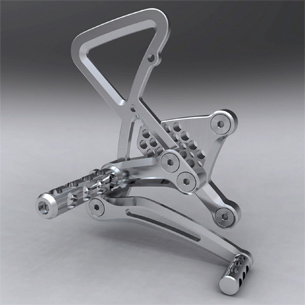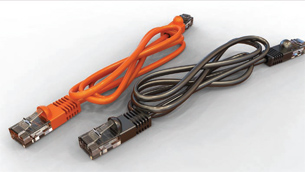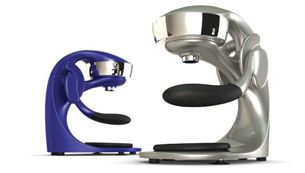Latest News
November 1, 2008
By Bob Cramblitt
« Pages 1 | 2
 Aftermarket modular and fully adjustable foot pegs for motorcycles designed by Gray Holland of Alchemy Labs and rendered in HyperShot. (Image courtesy of Alchemy) |
“We used to spend a lot of time setting up lights, tweaking materials, and doing test renderings to get an idea for what the final shots would look like,” says Grossman. “Imagine you were doing a painting and each time you made a brush stroke, you had to wait five minutes to see it appear on the canvas. And, on top of that, you weren’t sure what the color would look like once it was out of the tube. HyperShot has turned that type of process into a dynamic, interactive paint-by-numbers. It certainly has helped from a time standpoint, but as a consequence it also made a once laborious and stressful task quite fun.”
Renderings Without Pain
For industrial designers, generating photorealistic images in HyperShot is a simple four-step process:
- Import the 3D model; HyperShot supports standard data formats as well as native data from Pro/ENGINEER, SolidWorks, and Rhinocerous.
- Apply materials, color, and surface textures using an extensive palette within the software.
- Choose from HyperShot’s HDRI library or any other HDRI source to provide the lighting.
- Adjust the virtual camera for lens type, angle, rotation, and distance.
“The learning curve is almost non-existent,” says John Jacobsen of Smart Design, which has created iconic designs for clients such as OXO, Hewlett-Packard, Corning, Acer, and Kellogg’s. “It’s like a web browser. You get immediate results. A complex image that takes 10 hours with other 3D software can be completed in two hours with HyperShot. A designer’s role is to design, not render. At the end of the day, we want to deliver high-end renderings quickly, without the pain.”
Peter Kossev, principal of Pixel Mathematics, thinks it is funny to even call rendering a “process” in HyperShot. “It’s hardly a process at all anymore: we model, then we export into HyperShot, and the rendering is done in seconds.”
 This image of communication cables was part of a series of design studies by Pixel Mathematics. (Image courtesy of Pixel Mathematics) |
Kossev says that the software has ushered in a different approach to rendering at Pixel Mathematics, a company that provides industrial design and engineering services for some of the world’s leading companies.
“HyperShot entirely changed the way we go about things,” says Kossev. “We now take projects with deadlines that I would have never dared to take before. I have done a high-quality, 20-page brochure that shows the entire line of a company’s products in one day.”
Tapping into emotions
Unlike automotive photographers who use HyperShot to place 3D CAD models of cars into scenes that have been shot with a high dynamic range imaging camera, most industrial designers want the spotlight focused on the design aesthetics of the product.
“HyperShot allows me to show off a product on a clean background, making sure that materials and finishes are compelling,” says Jeff Bentzler of Stuart Karten Design, whose client list literally stretches from A (Abex) to Z (Zyliss). “The program allows for artistic creativity, letting the designer adjust lighting and surface reflections to achieve an added sense of realism.”
For industrial designers, it’s all about conveying the special feeling that resonates from a great design.
 This rendering of the Ojex juicer helped Smart Design win the 2000 IDEA Gold IDSA award. |
“It allows us to produce images that get our clients excited,” says Stuart Karten. “The high level of photorealism helps our clients to envision and embrace the appearance of their finished products at an early stage of the design process.”
Jacobsen of Smart Design says, “HyperShot lets us dial in quickly to get highlights on a desired location of the model. It helps us control the emotional content of an image. That’s crucial, because in today’s economy we’re selling an experience based on our ability to make strong emotional connections quickly.”Room for improvement
HyperShot is still in version one and, like any product at that stage, has room for improvement. Holland cites, for example, that texture and projection mapping is “fairly limited.” Still, this software is being adopted with a zeal rarely seen since the early days of 3D software.
“I have a wish list for what I want ]Bunkspeed] to do,” says Kossev, “but when I think about how this changed my life and how little I paid for it, it is forbidden to complain.”
More Info:
Alchemy Labs
San Francisco, CA
Bunkspeed
Los Angeles, CA
Design Edge
Austin, TX
Pixel Mathematics
Palo Alto, CA
Smart Design
New York, NY
Stuart Karten Design
Los Angeles CA
Bob Cramblitt, the former editor of Computer Graphics Today, has written about computer graphics technologies for more than 25 years. He owns Cramblitt & Company in Cary, NC, and writes about design, engineering, and IT technologies. Send e-mail about this article to [email protected].
« Pages 1 | 2
Subscribe to our FREE magazine, FREE email newsletters or both!
Latest News
About the Author
DE’s editors contribute news and new product announcements to Digital Engineering.
Press releases may be sent to them via [email protected].






